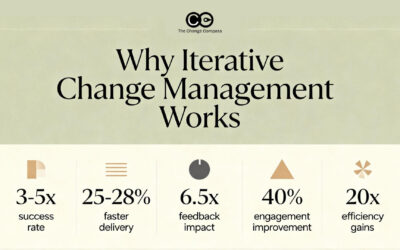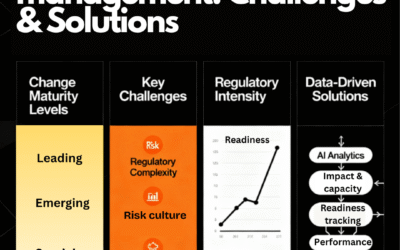Most of us work in organizations where change is the constant, and where at any one time there is a myriad of changes. What happens when there is a lot of changes being worked on? How do effective organizations manage change within this common environment? And what plays out when an organization adopts agile within this environment? Here we will illustrate how one organization effectively manages lots of changes within an agile environment.
Meet company A which is a typical financial services organization. They, like most other financial services organizations, are undergoing multiple changes. In change management theory land most are concerned with managing one change at a time. The reality for a lot of organizations is that there are lots of changes, some times up to hundreds of changes at a given point in time within an organization. This is not taking the lens of formal ’projects’ that would have formalized governance and resources in place to plan and deliver the initiative. From a user-centric lense, change is any initiative that involves changing a current way of working. These includes product changes, marketing campaigns, process changes, and role changes.
Like other organizations, company A has several business units, each of which has a range of initiatives that mainly impact their own business unit. However, some of these also impact other business units. At the same time, there is a company-wide body or governance group that determines which intiatives are to be funded centrally and are of higher priority, depending on the initiative benefit case, strategic importance and overall business value.
Towards the end of the year every year, there seems to be a phenomenon emerging in this company. Within an agile environment there are many agile teams are working in self-driven teams iterating on various changes. Many of the initaitives are also focused on delivering changes that impact frontline staff that work directly with customers. Most of these initiatives are aiming to implement the change prior to the end of the calendar year as the peak customer volume for this financial services firm tends to be between December and February. The idea is that if the changes were rolled out prior to December, then the change would take place in time to capture the peak volumes and therefore provide a quick realisation of benefits.
However, the scenario is that in true agile form, there is bound to be delays in each iteration. As each agile team starts to work through and iterate on the change, often there are technical delays or that the team realizes that the scope of the project requires a longer period of time to deliver. As a result, it is common to delay the eventual initiative go-live. When there are several initiatives aiming to go-live prior to the December period, this becomes a peak change impact period for the business. This means that there are simply too many initiatives trying to launch at the same time, causing operational performance challenges and business risks.
So how has Company A managed this situation?
Data
Armed with the quantitative data of the impacts of every initiative, programs, projects and initiatives, the picture was clear in terms of what this meant to the business. The frontline staff, as well as team leaders of the frontline, will require significant time away from their normal duties to understand, digest and embed the various changes. This presents real
challenges in terms of ensuring the right resourcing given the number of hours required to undergo changes. The business also has historical data of what happened last time this level of change had impacted the business and what this meant to business performance. The data also included the overall operational environment and any challenges including customer volumes, performance trends, etc.
Governance
A series of governance session was organized to zoom in on this specific scenario consisting of project delivery managers, change management, business leaders and other support professionals (e.g.initiatives risk). The session focused on discussing the various business risks and how to mitigate these risks, including prioritizing agreed critical initiatives,
understanding sequencing implications, and de-prioritizing non-critical initiatives. With each meeting, there was also continuing delays for some initiatives (again, in true agile form). As these potential or actual delays were socialized and shared, stakeholders kept updating their plan of attack to ensure the was an effective way of managing the situation.
The role of the change practitioner
The change management professional’s role in this context is to lead and facilitate the discussion of the governance and stakeholders so that there is clarity of what the data is telling us, what options we have to deal with it, and agreed actions forward. Program managers play a role in sharing ongoing progress in initiatives. Business stakeholders also play a critical role in understanding, accepting and agreeing to any actions, as well as sharing any shifting business performance priorities. However, the change professional plays a key role as the core of the problem as about managing and coordinating the amount and pace of change at a given point in time.
The solution
There was a series of solutions proposed to manage this overall peak change period:
1) Less critical initaitives were either pushed out or stopped. This lead to various re-planning exercises
2) Higher priority initaitives were clarified and agreed
3) A set of communication and engagement actions were proposed to better engage the impacted teams to help them joint-the-dots around the myriad of changes and what these meant
4) Careful and continual monitoring and reporting of business performance was emphasized to track the outcome of the changes
The illustrated case for Company A is a very common scenario for a lot of organizations within an agile environment. Initiatives cannot operate in silos if we adopt a user-lens in managing change and the impacts of change. This case illustrates how critical it is to have strong data that tells a clear story of what is going to happen to the business and what it means. Data enables effective and strategic conversations. Data also provides significant power and value in putting change management at the driving seat of business management.






